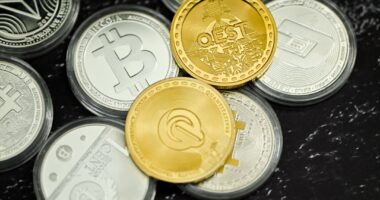NFTs, or non-fungible tokens, are unique digital assets stored on a blockchain, which is a decentralized and transparent digital ledger. Unlike fungible cryptocurrencies such as Bitcoin or Ethereum, NFTs cannot be exchanged on a one-to-one basis due to their unique nature. Each NFT represents a distinct digital item, often associated with digital artwork, collectibles, or other forms of digital content.
Blockchain technology is the fundamental infrastructure enabling NFTs. It creates a secure and transparent digital ledger that records the ownership and provenance of each NFT. Once an NFT is created and uploaded to the blockchain, its ownership and transaction history are permanently recorded and cannot be altered.
This immutability provides a high level of security and authenticity, which is particularly valuable in the art world where provenance and ownership are critical factors. The blockchain’s ability to establish and maintain a verifiable record of ownership and transactions is essential to the NFT ecosystem. It allows creators to prove the authenticity and uniqueness of their digital works, while collectors can verify the legitimacy and history of their purchases.
This technology has opened up new possibilities for digital artists to monetize their work and for collectors to invest in and trade digital assets with confidence.
Key Takeaways
- NFTs are digital assets that represent ownership of unique items using blockchain technology.
- When choosing a platform for NFT creation, consider factors such as fees, user interface, and community support.
- When creating and uploading digital artwork for NFTs, ensure that the file meets the platform’s requirements and consider adding metadata to enhance its value.
- Minting an NFT involves creating a unique token on the blockchain and setting a price for it, taking into account factors such as rarity and demand.
- Promote and sell your NFT artwork through social media, online marketplaces, and collaborations with other artists to reach a wider audience.
- Stay updated on NFT trends and marketplaces to understand the demand for different types of digital art and make informed decisions about your portfolio.
- Manage your NFT portfolio and transactions by keeping track of sales, royalties, and potential copyright issues, and consider seeking professional advice for financial and legal matters.
Choosing the Right Platform for NFT Creation
Popular NFT Marketplaces and Platforms
Once you have a solid understanding of NFTs and blockchain technology, the next step is to choose the right platform for creating and selling your NFT artwork. There are several popular NFT marketplaces and platforms available, each with its own unique features and benefits. Some of the most well-known platforms include OpenSea, Rarible, and Foundation, each offering different tools and services for artists and collectors.
Factors to Consider When Choosing a Platform
When choosing a platform, it’s important to consider factors such as fees, user interface, community engagement, and marketplace reach. Some platforms may charge higher fees for minting and selling NFTs, while others may offer lower fees but have a smaller user base. Additionally, some platforms may have a more active and engaged community of artists and collectors, which can help with promoting and selling your artwork.
Platform Features and Integration
It’s also important to consider the platform’s user interface and ease of use, as well as its integration with popular cryptocurrency wallets such as MetaMask or Trust Wallet. This will ensure a seamless experience for both you and your potential buyers.
Choosing the Right Platform for Your Needs
Ultimately, the right platform for you will depend on your specific needs and goals as an NFT artist. By considering these factors, you can make an informed decision and choose a platform that will help you successfully create, promote, and sell your NFT artwork.
Creating and Uploading Your Digital Artwork
Once you’ve chosen a platform, the next step is to create and upload your digital artwork. This can be anything from digital paintings and illustrations to 3D models and animations. When creating artwork for NFTs, it’s important to consider factors such as file format, resolution, and copyright ownership.
Most platforms will have specific guidelines for uploading artwork, including file format requirements and size limitations. It’s important to follow these guidelines to ensure that your artwork is displayed correctly and can be easily viewed by potential buyers. In addition to technical considerations, it’s also important to consider copyright ownership when creating NFT artwork.
If you are using existing images or assets in your artwork, it’s crucial to ensure that you have the legal right to use and sell those assets as part of an NFT. This may involve obtaining permission from the original creators or purchasing royalty-free assets from reputable sources. By taking these factors into account when creating and uploading your artwork, you can ensure that your NFTs are of high quality and comply with legal and technical requirements.
Minting Your NFT and Setting a Price
Once your artwork is uploaded to the platform, the next step is to mint your NFT and set a price for it. Minting an NFT involves creating a unique token on the blockchain that represents your artwork. This process typically involves paying a minting fee, which can vary depending on the platform and the size of the file being minted.
After minting your NFT, you can then set a price for it in cryptocurrency, such as Ethereum or USD Coin. When setting a price for your NFT, it’s important to consider factors such as the quality of your artwork, market demand, and comparable sales on the platform. Setting the right price for your NFT is crucial for attracting potential buyers and maximizing your earnings.
If your price is too high, it may deter buyers from purchasing your artwork, while setting it too low may undervalue your work. It’s important to research similar artworks on the platform and consider factors such as rarity, artistic merit, and market trends when setting your price. Additionally, some platforms may allow you to offer limited edition or unlockable content with your NFTs, which can add value and justify a higher price.
By carefully considering these factors when minting and pricing your NFTs, you can increase your chances of selling your artwork at a fair price.
Promoting and Selling Your NFT Artwork
After minting and pricing your NFT artwork, the next step is to promote it and attract potential buyers. This can involve various marketing strategies, such as social media promotion, community engagement, and collaboration with other artists. Many successful NFT artists use platforms like Twitter, Instagram, and Discord to showcase their artwork and engage with their audience.
By sharing behind-the-scenes content, work-in-progress updates, and personal insights into your creative process, you can build a loyal following of collectors and fans who are interested in purchasing your NFTs. In addition to social media promotion, collaborating with other artists and participating in community events can help increase the visibility of your artwork. Many NFT platforms host virtual galleries, auctions, and exhibitions where artists can showcase their work to a wider audience.
By participating in these events and engaging with other artists and collectors, you can build valuable connections within the NFT community and increase the chances of selling your artwork. It’s also important to regularly update your portfolio with new artwork and engage with potential buyers to maintain interest in your NFTs.
Staying Updated on NFT Trends and Marketplaces

Staying Ahead of Market Trends
As the NFT market continues to evolve, it’s essential for artists to stay updated on current trends and marketplaces. This involves keeping an eye on popular NFT platforms, monitoring sales data, and staying informed about new developments in the industry. By doing so, you can identify emerging opportunities, adapt your strategy to changing market conditions, and make informed decisions about pricing and promotion.
Legal and Regulatory Developments
In addition to market trends, it’s crucial to stay informed about legal and regulatory developments related to NFTs. As the popularity of NFTs continues to grow, there is increasing scrutiny from regulators and lawmakers around the world. This includes issues related to copyright infringement, money laundering, and investor protection.
Ensuring Compliance with Laws and Regulations
By staying informed about legal developments and best practices for creating and selling NFT artwork, you can ensure that your work complies with relevant laws and regulations. This is vital for maintaining a successful and sustainable career in the NFT space.
Managing Your NFT Portfolio and Transactions
Finally, once you have successfully sold your NFT artwork, it’s important to manage your portfolio and transactions effectively. This can involve keeping track of sales data, managing royalties from secondary sales, and maintaining relationships with collectors. Many platforms offer tools for managing your NFT portfolio, including sales analytics, transaction history, and royalty management features.
In addition to managing your portfolio, it’s also important to consider tax implications related to selling NFT artwork. Depending on your country of residence, selling NFTs may have tax implications that need to be considered. It’s important to consult with a tax professional or accountant to ensure that you are compliant with relevant tax laws and regulations.
By effectively managing your NFT portfolio and transactions, you can maximize the value of your artwork and build a successful career as an NFT artist. This involves staying organized, maintaining good relationships with collectors, and staying informed about legal and financial considerations related to selling NFTs. By taking these factors into account, you can ensure that your experience as an NFT artist is both rewarding and sustainable in the long term.
FAQs
What is an NFT art?
NFT stands for non-fungible token, and NFT art refers to digital artwork that is tokenized on a blockchain, making it unique and irreplaceable.
How do I create an NFT art?
To create an NFT art, you will need to choose a digital artwork or create one, then mint it as an NFT on a blockchain platform such as Ethereum or Binance Smart Chain.
What are the steps to create an NFT art?
The steps to create an NFT art include choosing or creating digital artwork, selecting a blockchain platform, creating a digital wallet, minting the artwork as an NFT, and listing it for sale on a marketplace.
What are the benefits of creating NFT art?
Creating NFT art allows artists to tokenize their digital creations, proving ownership and authenticity, and potentially earning royalties from future sales.
What platforms can I use to create NFT art?
Popular platforms for creating NFT art include Ethereum-based platforms like OpenSea, Rarible, and Foundation, as well as Binance Smart Chain-based platforms like BakerySwap and Nifty Gateway.
What kind of digital artwork can be turned into NFT art?
Almost any form of digital artwork, including illustrations, animations, videos, music, and virtual reality experiences, can be turned into NFT art.





